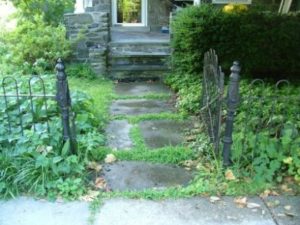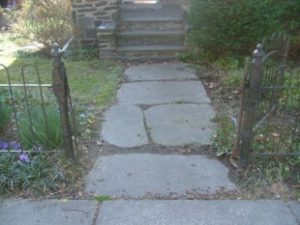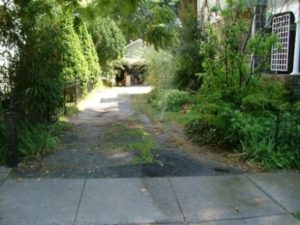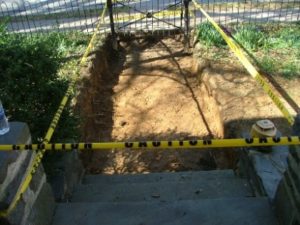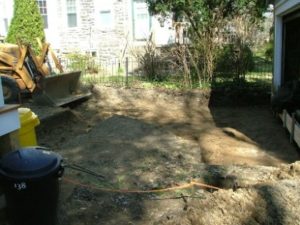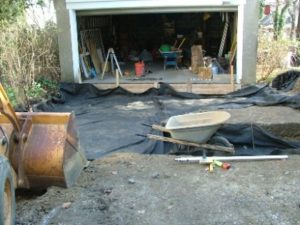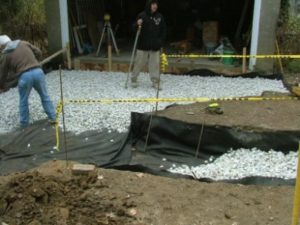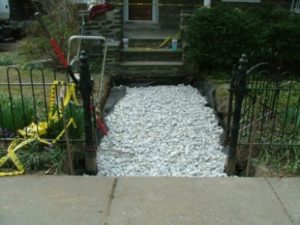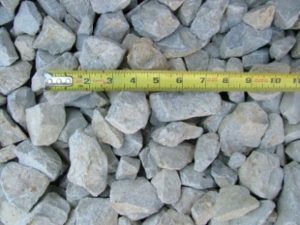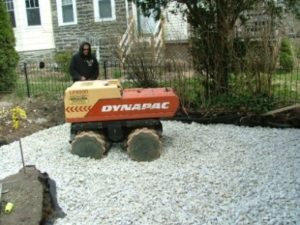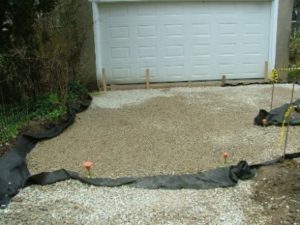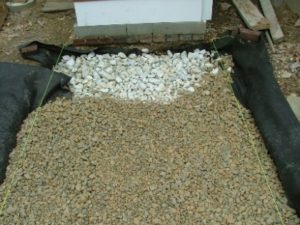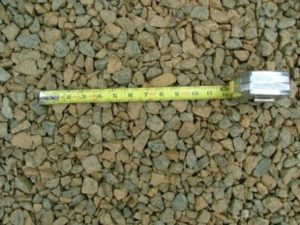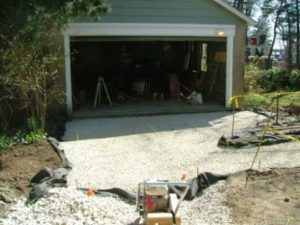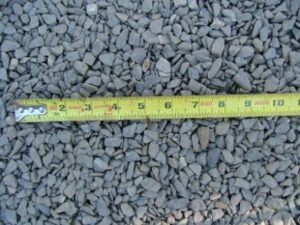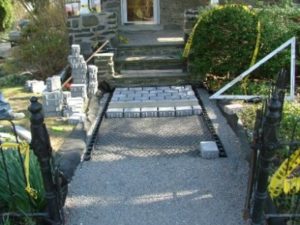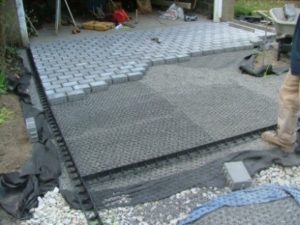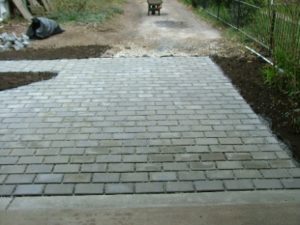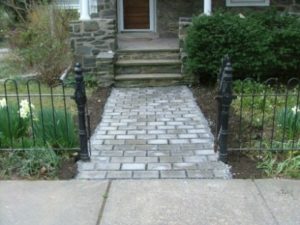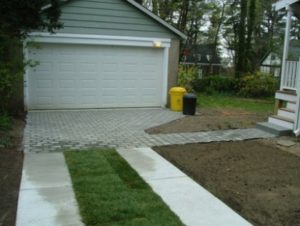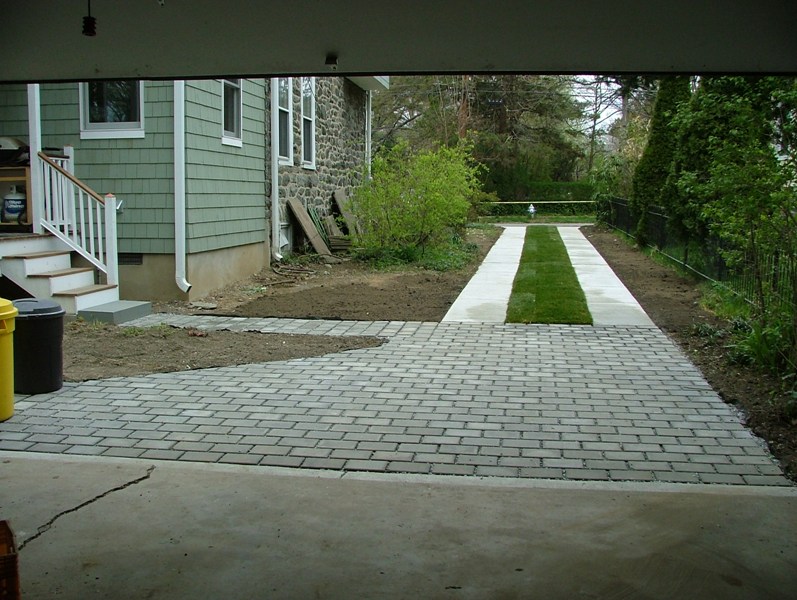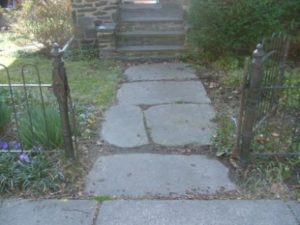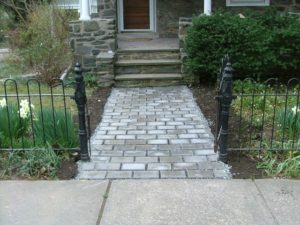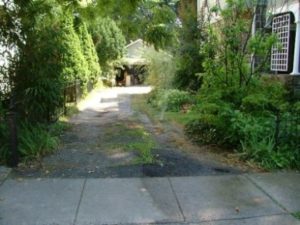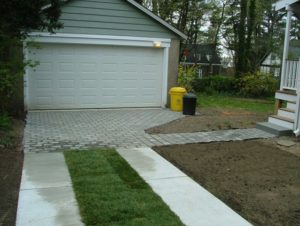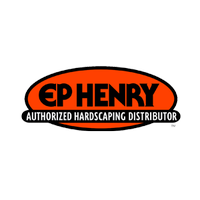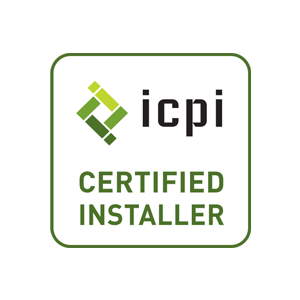Permeable Pavers may not be the first choice of most people today when thinking of a Driveway, Patio, a Walk or Walkway, but things are changing. As more and more open space is covered with paving, areas that use to soak up rainwater are now impervious. More water is put into the streets, storm sewers, and waterways immediately during, and after a storm instead of soaking into the ground and slowly working it way back into the water system. The EPA, and in Pennsylvania the DEP have regulations that call on municipalities to limit the amount of impervious area on properties in their jurisdiction. This is to help prevent flooding that can result from too much paving and building. Impervious areas include the house, the driveway, walks, patios, sheds, and pools. Even decks in some areas are considered impervious. Although pavers, flagstone and other natural stone, and clay brick might not be installed in the mortar or over concrete, they are usually counted as impervious because of the compaction of the ground necessary for proper construction. Most of the rainwater will run off the top, much the same as if it were concrete.
This is why environmentally friendly permeable paving is gaining in popularity. Most municipalities – but not all – will allow Permeable Pavers for Driveways, Patios, and Walks when a property is at its limit for an Impervious area. In a permeable system, the base is constructed of clean stone over an un-compacted subsoil that will absorb the rainwater that comes through. The base stone layers are constructed thick enough to hold up to the traffic that it will receive, and the base stone is compacted. The pavers are installed on a layer of 3/8-in. stone (not sand) with a larger joint than with impervious pavers and these joints are filled with small stone (never sand) to allow for water to run through.
Some additional benefits of permeable paving:
- Environmentally friendly. Fits in nicely with a responsible, sustainable lifestyle.
- Qualifies as a Best Management Practice and can help earn credit towards LEED certification.
- Snow and ice that melts in Winter will disappear below the paving surface, lessen the need for salt and make for a safer surface. This could have many commercial applications in business districts.
- Can eliminate the need for a drainage pond or collection basin in a parking lot. This can make additional space available for parking.
- For the last few years, new styles and colors have been added each year, and the look of permeable pavers can rival regular pavers. Check out manufacturers websites for more up to date information. To order the current year’s catalog see E. P. Henry, Techo-Bloc or other paver companies websites.
- See construction detail below. Because water has to drain through, the construction is very different than a regular paver job.
Permeable Paver Walk and Driveway – Bala Cynwyd, Montgomery County, PA 19004
This permeable walk and driveway was constructed for a customer in Bala Cynwyd, PA. He wanted to build an addition on his house, and in order to do so, he had to eliminate some impervious paving outside the house. He was able to do this while still retaining the paved walking surfaces he had before the addition.
Shown here are steps during construction:
- Before photo of the front walk in summer. Even though it is pieces of flagstone set in soil it is considered impervious by Lower Merion Township.
- Before photo of the front walk.
- Before photo of the driveway. The whole driveway was removed and replaced with permeable pavers by the garage, and two strips of concrete with sod in the center closer to the street.
- Excavation for the walk. The area was excavated down 15-inches for the walk.
- Excavation for the driveway. The area was excavated down 15-inches for the driveway. The subsoil is not compacted to allow for water to drain better.
- Lower Merion requires a filter fabric between the subsoil and the stone base. This is not specified by the ICPI so check with local zoning for rules that may be specific to your local area.
- In this application 6-inches of #2 stone (about1 1/2 to 3-inch stone) is spread first over the fabric.
- The large spaces between the stones hold a lot of water while the water is being adsorbed into the soil.
- A close-up photo of the #2 stone.
- The 6-inch stone layer is compacted with a static roller as recommended by ICPI
- The next layer is 4-inches of #57 stone -also called 2B in PA or 3/4-inch stone
- Shown here is the #57 stone in the front and the #2 stone in the back. A 6-inch thick piece of bluestone was installed over the #2 stone as a step that was needed to transition to the deck steps.
- A close-up photo of the #57 (3/4-inch)stone.
- A 2-inch layer of #8 (3/8-inch) stone is installed next as a bedding layer for the pavers. No sand is used when installing permeable pavers.
- A close-up photo of the #8 (3/8-inch)stone.
- Special edging (with a geogrid attached to go under the pavers) is installed on the outside as a restraint to keep the pavers from moving.
- The edging for the driveway has been placed over the bedding layer, and the pavers are being installed. Notice the bumps on the paver in the foreground. These are used as spacers to get the proper joint width.
- The pavers are tamped into the bedding layer and additional #8 (3/8-inch) stone is swept into the joints to allow for the drainage through the pavers..
- The finished walk.
- The finished permeable driveway by the garage with concrete strips and grass closer to the street. Even in the winter sand should be kept off of the pavers for maximum permeability.
- The finished permeable driveway by the garage with concrete strips and grass closer to the street. Joints can be cleaned if they do get dirty, and the water is not draining at the right speed.
EP Henry Eco Paver Permeable Paver Walk – Bala Cynwyd, Montgomery County, PA 19004
- Before
- After
EP Henry Eco Paver Permeable Paver Driveway – Bala Cynwyd, Montgomery County, PA 19004
- Before
- Atfer

